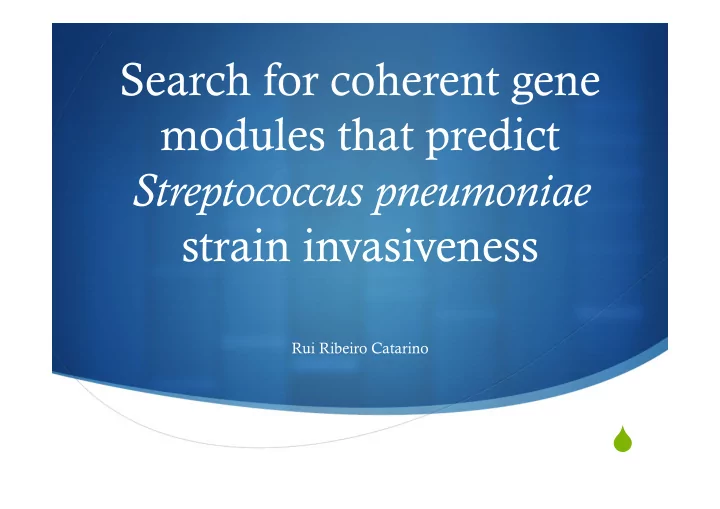

Search for coherent gene modules that predict Streptococcus pneumoniae strain invasiveness Rui Ribeiro Catarino S
Streptococcus Pneumoniae S Streptococcus pneumoniae , or pneumococcus, is a commensal gram positive bacteria in the human respiratory tract. S Pathogen responsible for diseases such as pneumonia, otitis, meningitis and sepsis.
Streptococcus pneumonia . Why? UNICEF/WHO,Pneumonia: The forgotten killer of children,2006
Transmission and Carriage Nasopharyngeal carriage may occur in up to 60% of healthy pre-school children and up to 30% of healthy older children and adults Nasal cavity Asymptomatic carrier Nasopharynx: site of colonisation Aerosol Trachea Inhalation Patient with pneumococcal disease Dissemination Fedson, Musher, in Vaccines, 1994 Musher, in Principles and Practice of Infectious Diseases, 1995
Invasiveness S Strain invasiveness is related with its probability to be isolated from patient with pneumococcal invasive disease. S From observational studies: Carriage Invasive Disease a b Clone A c d Not Clone A S Invasiveness OR=ad/(cb)
Epidemiological data – Strain Invasiveness Sá Leão et al 2011
Genetic Diversity S S. pneumoniae is very diverse. The pangenome is estimated to be more than 2 times the size the average strain. (Donati, C et el, Genome Biology, 2010 vol 11(10) p R107) S Naturally competent S High frequency of homologous recombination - a single nucleotide changes by recombination 50 times more frequently than by mutation (Feil, EJ et al, Genetics. 2000 Apr;154(4): 1439-50)
Comparative Genomic Hybridization S Genomotyping of test strains. S Control strains R6, Tigr4 and G54 are from different serotypes and have different invasive behaviors. Strain 1 Strain ... Strain 72 1 ... 1 Gene 1 0 ... 1 Gene 2 0 ... 0 Gene 3 ... ... ... Gene ... 1 ... 0 Gene 3620
Invasiveness Determinants S Invasiveness Determinants - Genes whose presence is associated, experimentally or observationally, with diseases caused by pneumococcus. S Capsule genes, adesines and toxines are well documented Invasiveness Determinants. S Contradictory results spawn from the highly variable genome between strains.
Genes don’t work alone… S It is a cellular process that is associated with invasive disease (or colonization) S A strain can be a colonizer because it lacks a few genes of the module necessary to carry that process
Networks S An analysis of all possible gene combinations would be unfeasible. But we can look only for known interactions. S Biological network limit the number of gene combinations and assure an easy interpretation.
Networks in Cells S Metabolic network S Protein interaction network S Transcription regulatory network S Signal transduction networks
Distance matrix S A gene distance matrix was created using the aCGH and epidemiological data. S Genes distance depends on their co-occurrence in invasive strains.
Module search S Modules with different sizes were created from each gene, joining the closest neighbors on the distance matrix. S These modules were later evaluated in order of classification performance and statistical significance.
Module Evaluation S A threshold ( t ) is selected for each 6 module to maximize the Invasive 6 Predictive Value (IPV). 5 S A module is present in a strain if there 4 are at least t genes of the module in the 4 strain. 1 S IPV is the ratio of invasive strains where 0 the module is present. 0
Results
Modules Overlap
Correlation with Invasiveness
Functional Analysis S Invasive behavior depends on several independent features. S We hypothesize the genes identified play roles in some of these features such as: S adaptation to new environments S survival with different nutrient sources S interaction with the host S generating genetic diversity.
Adaptation to the Environment Osmotic Anaerobic regulation response ( 2 ) ( 3 ) Adaptation to the Environment
Nutrient Availability Amino acid Carbohydrates metabolism metabolism ( 8 ) ( 10 ) Transport Proteolysis ( 19 ) ( 4 ) Nutrient Availability
Interaction with the Host Toxins ( 11 ) Choline Cellular Binding Envelope Proteins ( 7 ) ( 2 ) Interaction with the Host
Genetic Diversity DNA recombination IS/Transposons and repair ( 6 ) ( 12 ) Competence tRNA ( 4 ) ( 4 ) Genetic Diversity
Conclusions S It was possible to identify 26 (highly overlapping) gene modules associated with invasiveness S Some of the genes were previously associated with invasiveness, while other still need to be studied S No gene modules were found associated with colonization
Future work S Module definition needs perfection to allow for a module- wise interpretation of function. S Apply same strategy with the metabolic and transcriptional networks
Acknowledgements Enzimology group: research grant PTDC/EBB-EBI/113824/2009 PTDC/BIA-MIC/101375/2008 The Boss: Francisco Pinto
Recommend
More recommend